Pa., N.J., and other states are cutting environmental spending at the worst time, report finds
Pennsylvania cut its spending on core environmental protection programs by 16% over a ten year period when adjusted for inflation, New Jersey cut 20 percent and Delaware slashed 33 percent, according to a report released Thursday by the Environmental Integrity Project.

Over a 10-year period, Pennsylvania cut its spending on core environmental protection programs by 16%, New Jersey cut 20%, and Delaware slashed 33%, all in inflation-adjusted dollars, according to a report released Thursday by the Environmental Integrity Project.
The cuts come as the Trump administration’s push for “cooperative federalism” grows, meaning states are expected to shoulder more of the burden for the environment as the federal government pulls back, the report said.
“This is just a shell game, however,” said Eric Schaeffer, executive director of the Environmental Integrity Project and a former Environmental Protection Agency official, “because state agencies are often badly understaffed and the EPA workforce is already at its lowest level in more than 30 years.”
Pennsylvania Department of Environmental Protection officials, however, took issue with what the Environmental Integrity Project decided to include or exclude in its accounting. DEP spokesperson Elizabeth Rementer said, “The analysis removes numerous core DEP programs, and thus does not present a full picture of the agency’s finances.”
The Environmental Integrity Project, which bills itself as a nonpartisan, nonprofit advocacy organization, compiled publicly available budget data for its report, “The Thin Green Line: Cuts to State Pollution Control Agencies,” which looked at spending by the lower 48 states on environmental protection from 2008 to 2018.
Though Pennsylvania was not one of the top states for cuts, the report singles it out because reductions from 2008 to 2018 came during an energy boom with the rise of hydraulic fracturing, known as fracking, in the Marcellus Shale. The report also notes Pennsylvania has failed to meet obligations to reduce pollution that feeds into the Chesapeake Bay.
Yet overall state spending grew 18% in that period, the report says.
The report states that Pennsylvania budgeted almost $556 million for environmental protection in 2008. However, the authors adjusted the figures for 2018 inflation levels, bringing the 2008 total to $650 million. Pennsylvania budgeted about $550 million in 2018 for what the report counted as environmental protection programs.
So, the reduction between the inflation-adjusted number and the most recent year is just shy of 16%.
“From soup to nuts, when you make steep cuts in revenue at the Pennsylvania Department of Environmental Protection and then lose staff and expertise, not surprisingly your ability to run the agency and protect the environment is chopped off at the knees,” David Masur, director of the nonprofit advocacy organization PennEnvironment, said in reaction to the report.
Initially, the report said Pennsylvania had made the biggest cuts of any state. But representatives from Gov. Tom Wolf’s administration, including DEP officials, took exception to the calculations. In response to figures supplied by the administration, the report’s authors revised the numbers, and Pennsylvania no longer is the worst or even among the top 10 worst states.
But the DEP still disputed the revised numbers, saying the final budget numbers were much higher than the Environmental Integrity Project cited. Rementer said Wolf’s budget “provided $789,603,000 in funding to enable DEP to carry out its mission of protecting Pennsylvania’s air and water, an increase of over $150 million or 25%.”
The Environmental Integrity Report also says New Jersey budgeted $283 million in 2008, which comes to $331 million when adjusted for inflation. Compared with $292 million in 2018, the reduction was about 12%.
Delaware budgeted $46.1 million in 2008, $54 million when adjusted for inflation, according to the report. Environmental spending dropped to $36.3 million in 2018 for a reduction of about 33%.
Nationwide, the report stated:
Thirty states reduced funding for their environmental agencies on an inflation-adjusted basis. Twenty-five states imposed cuts of at least 10%, and 16 states reduced spending by more than 20%.
Seven of 10 states with the sharpest cuts are coastal states facing damage from rising sea levels, including North Carolina, Louisiana, and New York.
Overall, states eliminated more than 4,400 positions at agencies responsible for protecting the environment.